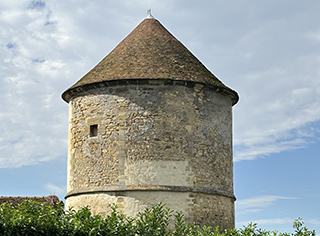
Sentiers du Patrimoine ®
ableiges
Ancien château et ferme seigneuriale

Redescendre la rue Gilles de Maupéou et voir juste avant la voie de chemin de fer le panneau sur la Viosne et l’ancienne gare.
Prochain point : Lat. 49.07815, Long. 2.09917
The existence of a château and a seigneurial farm is attested in written sources as early as 1399. The château, along with the seigneury, was purchased in 1614 by Gilles de Maupéou, a nobleman who founded an important lineage, with all firstborn sons bearing the name Gilles. The Maupéou family was elevated to the title of Count in 1692. Their coat of arms features a porcupine, which still remains the emblem of Ableiges today. You can see on old maps that the château consisted of a main residence flanked by two wings, bordered by courtyards and gardens. However, it was dismantled during the Revolution and finally destroyed in 1880. Today, only a tiny portion remains of this 80-hectare estate, which once stretched on both sides of the present-day road. A bourgeois house, referred to as “the château,” was built in the late 19th century opposite the farm, but only the entrance gate and outbuildings still exist.
The seigneurial farm stood to the north of the château to which it was attached. Several parts still remain today: the residence, a barn, and above all the dovecote, built in the 16th or 17th century to breed pigeons. Under the Ancien Régime, these birds were highly valued both for their meat and for their droppings, known to be an effective fertilizer. Owning a dovecote was a seigneurial privilege, extended to wealthy landowners starting in the 16th century. Indeed, this control made it possible to regulate pigeon populations and thus protect crops from the damage caused by too many birds. Old maps show that this dovecote was totally part of the farm and formed one corner of its square courtyard. Today, it stands as one of the emblematic heritage features of Ableiges.

